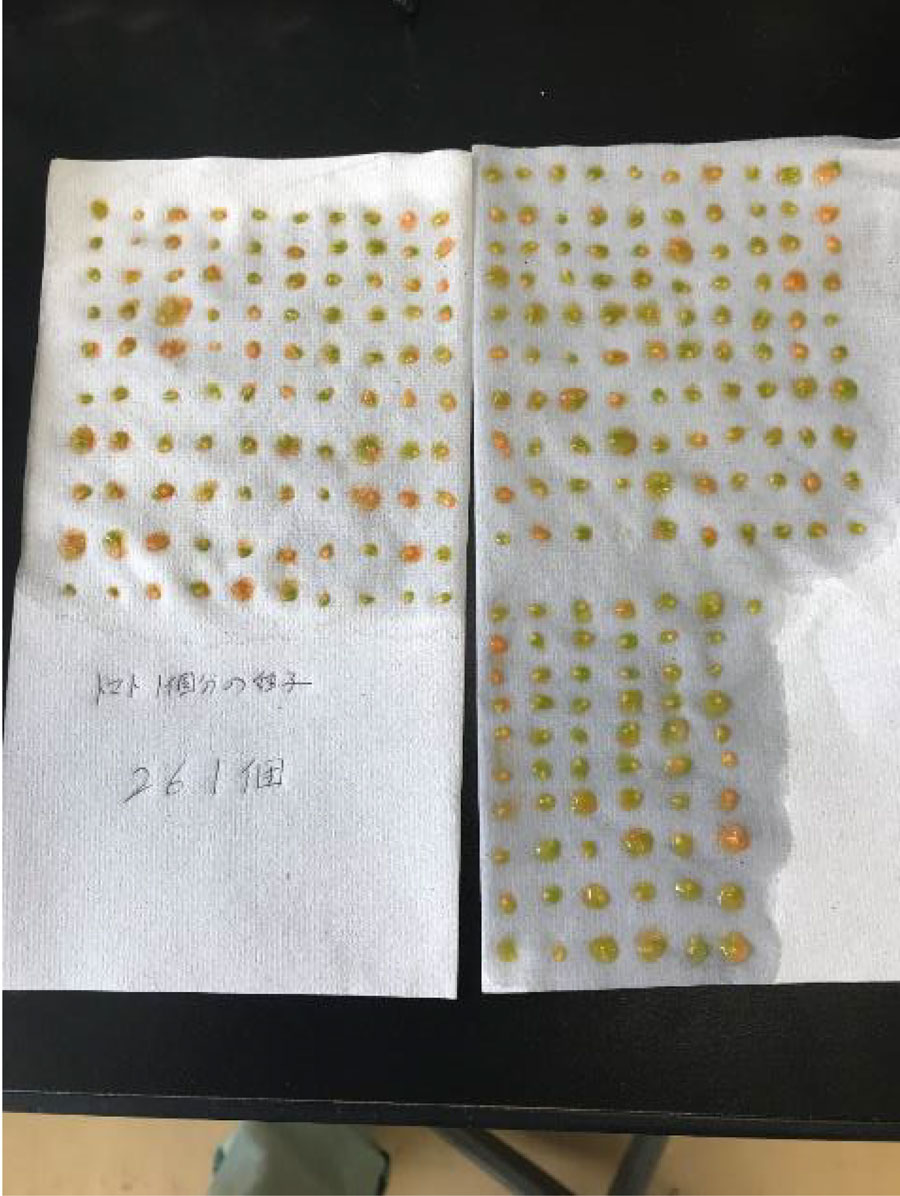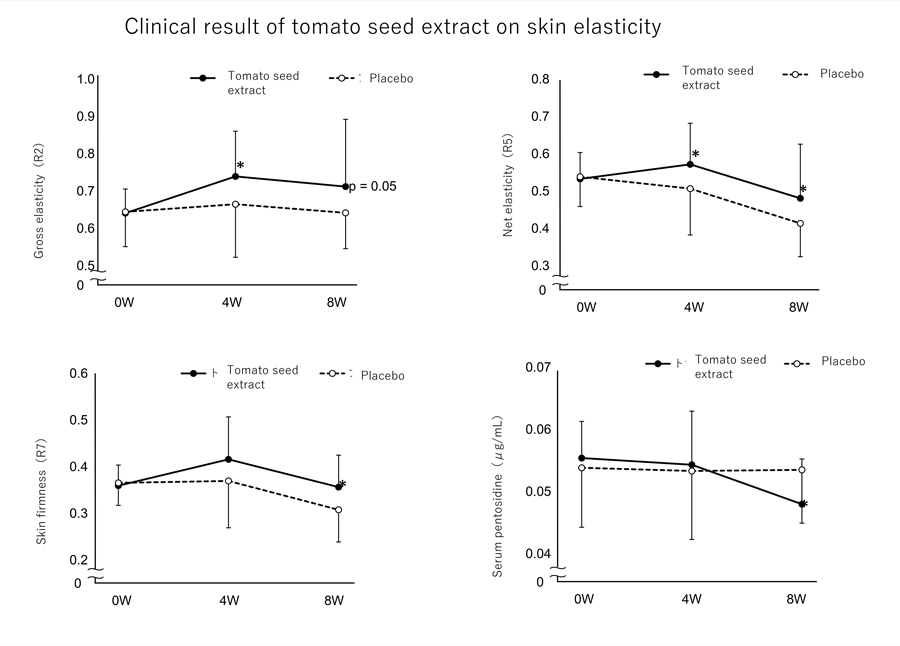Tomato seed saponins promise to cure dermatitis
Dr Hiroshi Shimoda from Oryza Oil & Fat Chemical Co Ltd and Professor Toshio Morikawa of Kindai University conducted a study on the chemical composition and bioactive properties of tomato seeds. The researchers found steroidal saponins called lycoperosides, previously associated with skin-health promotion, to be the major seed components, more abundant in seeds than in tomato fruits. The researchers further demonstrated that these saponins cure inflammation and damaged skin in atopic dermatitis.
Dr Hiroshi Shimoda’s laboratory is dedicated to the study of edible seed components. One example of these components are molecules from the class of polyphenols called flavonoids that protect seed oils from oxidation. These types of molecules are beneficial to our health, which is why we use the seed extracts that contain them to produce dietary supplements, as well as Food for Specified Health Uses, also known as FOSHU products. The recent focus of Shimoda’s studies has been on saponins found in tomato seeds.
Tomatoes, saponins and dermatitis
Tomatoes originated in the Andes highlands in South America, but today they are grown worldwide. Tomato fruit can be consumed raw or processed and it is known to have cholesterol-lowering properties as well as an effect on reducing blood pressure. Tomato fruit is especially rich in vitamin C and lycopene, an antioxidant with roles in sun protection, heart health improvement, and protection against certain types of cancer. However, the fruit contains various other beneficial compounds, including vitamins, carotenoids, flavonoids, and saponins.

While knowledge of tomato saponins is limited, saponins in general are known to exhibit a plethora of biological benefits including anti-inflammatory and wound-healing effects. Lycoperosides and esculeosides are steroidal saponins that have been isolated from tomatoes. Esculeoside A, a member of the esculeoside family of saponin compounds found in fully ripe tomato fruits, was reported to prevent arteriosclerosis in mice. It was also reported that orally administered esculeoside A reduced serum cholesterol and low-density lipoprotein-cholesterol in mice deficient in lipid-binding proteins. Moreover, it was found that oral administration of esculeoside B isolated from tomato juice improved type IV allergic dermatitis in mice.
Shimoda and Morikawa investigated the effects of tomato seed extract and lycoperoside H on atopic dermatitis symptoms.
Dermatitis is a broad term that describes a common skin irritation. It has a number of causes and many forms which usually involve a rash, or itchy and dry skin. As a result of dermatitis, the skin might blister, ooze, crust, or flake off. Atopic dermatitis (AD) is an allergic dermatitis with complex and diverse symptoms. The pathology of AD is characterised by pruritus (itchy skin), severe inflammation, and keratosis (a noncancerous skin condition manifested as a waxy brown, black, or tan growth). AD can be treated by the systemic application of corticosteroids of varying strength, as well as by using an immunosuppressive ointment, such as tacrolimus.

Saponins for healthy skin
Saponins are generally recognised to have a smoothing effect on our skin when applied topically. Some saponins can also promote wound healing and cure inflammation when applied orally. There are many examples of saponins in the literature exhibiting these effects. One example are centella saponins, found in the leaves and stems of the Indian Ayurvedic herb Centella asiatica, which are known for promoting collagen production and stimulating wound healing. Another widely known example is Korean ginseng which contains a type of saponin named ginsenosides. It was found that oral administration of ginsenoside-containing Korean ginseng extract improved trans epidermal water loss (TEWL), which reflects skin barrier function in mice with AD indicating an increase in anti-inflammatory effects and skin hydration. Ginsenoside Rg1, in particular, mitigated the increase in TEWL in the skin of hairless mice, damaged by UV radiation.
Apart from anti-inflammatory activity, ginsenoside Rc contributed to epidermal moisture retention through upregulation of key genes involved in the process. TEWL in AD mouse models was also improved by gracillin, a spirostan-type saponin isolated from the plant Dioscorea quinqueloba. Saponins from the plant Centella asiatica were found to reduce epidermal dehydration as well. Specifically, a major pentacyclic triterpene saponin called madecassoside, present in C. asiatica, reduced TEWL and enhanced several moisturising molecules, including aquaporin-3, loricrin, and involucrin. Topical application of the cosmetic formulation comprised of C. asiatica extract has therefore found a use in skin moisturisation and anti-inflammation.

From the seed to the mouse to the cure
While much is known about the composition and properties of tomato fruit, similar knowledge of the tomato seed was lacking. Shimoda and his colleague Professor Toshio Morikawa investigated the chemical composition and bioactive activity of tomato seed and found lycoperoside saponins to be the major seed components, more abundant in seeds than in tomato fruits. Based on the reported effects of saponins, Shimoda and associates hypothesised that saponins from tomato seeds may cure inflammation and damaged skin in AD.
Until recently, NC/Nga inbred mice have been used as rodent models in AD research aimed at identifying viable drug candidates, including natural products. However, to induce symptoms of edema or swelling caused by excess fluid trapped in the tissues, a particular chemical would have to be topically applied to the ears of these mice. Nowadays, interleukin (IL)-33 transgenic (IL-33Tg) mice that do not require any such treatment are being used as an alternative to NC/Nga mice to assess the efficacy of AD remedies.

Loosely defined, cytokines are strong bioactive proteins that are important in cell signalling and IL-33 is a cytokine that plays a pivotal role in allergic disorders. IL-33 is expressed in epithelial or endothelial cells and it serves as an endogenous danger signal that activates innate immunity as it is released rapidly after cellular damage or stress. In IL-33Tg mice, IL-33 is upregulated which leads to AD-like inflammation. The transgenic animals exhibit epidermal hyperplasia, or enlargement of the skin tissue, and an extreme scratching behaviour as the symptoms progress. IL-33 activates the immune system by promoting the activation of Th2 lymphocytes, mast cells, and eosinophils. Consequently, activated Th2 lymphocytes release Th2 cytokines, which include IL-4, -5, -6, -9, -10, and -13. Of these cytokines, IL-4 and -13 have been associated with the deterioration of AD symptoms. Therefore, these cytokines are studied as targets for AD-suppressing drugs.
While much is known about the composition and properties of tomato fruit, similar knowledge on the tomato seed was lacking.
Tomato seed to cure dermatitis
In light of previous findings that tomato saponins had a suppressive effect on AD, Shimoda and associates investigated the effects of tomato seed extract (TSE) and lycoperoside H (LH) on AD symptoms in IL-33Tg mice. This was the first study to demonstrate the efficacy of natural products in this mouse model. In their study, the scientists gave TSE or LH to mice with AD symptoms. As a result of four-month administration, AD inflammation and TEWL were suppressed by TSE and LH. TSE slightly suppressed scratching behaviour, while TSE and LH both increased locomotive activities. Moreover, LH administration clearly suppressed the accumulation of inflammatory cells in skin lesions and epidermal hypertrophy. Therefore, the researchers found that LH was a candidate for an anti-inflammatory edible seed compound to cure AD symptoms.

Various edible plants contain a glycosylated form of ceramides, sphingolipids that play an important role in skin-barrier function. These glucosylceramide rich plant extracts are often used as dietary supplements and beverages to aid skin hydration. Another way of improving dry skin symptoms is to use compounds that can increase skin ceramide by inducing internal ceramide synthesis. Oral supplements are generally considered more practical compared to applying moisturising cream on large surfaces of the body.
To gain insight into the mechanism by which LH inhibited AD symptoms and to further investigate other saponins from tomato seeds, Shimoda and Morikawa designed a cell-based study. In a 3D cultured epidermis model, almost all tested tomato seed saponins reduced TEWL. However, LH was considered additionally beneficial as it was the only compound found to boost skin-barrier function through increased ceramide production.
TSE containing LH has been commercially available since 2019 and it has been marketed as being able to enhance skin elasticity. This role of TSE and LH was deduced while investigating barrier functions. Shimoda and associates are planning a new clinical trial that will look into the effect of LH on reducing dry skin symptoms and they seek to further expand the knowledge base on the roles of tomato seed saponins and LH.

Personal Response
What advantages would LH offer in treating AD compared to the remedies that are already available?
One advantage of LH is cost. The price of LH (10mg) enriched TSE (150mg) is less than US1$. This is one 2,000th or fewer than an Olumiant tablet (Lilly), a JAK inhibitor recently permitted as an orally effective AD medicine in Japan. It is able to maintain a less inflammatory and hydrated skin condition for daily use. Another advantage is safety. LH is a non-toxic saponin for a wide range of people who have different ethnic and metabolic backgrounds. No side effects have been reported so far. Therefore LH appears to be a vegetable-derived safe AD treatment.